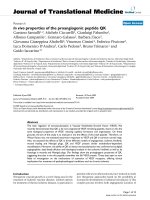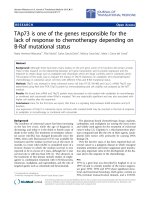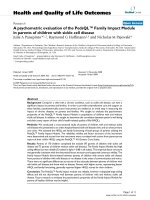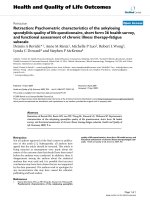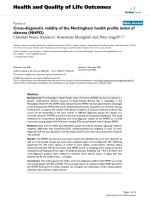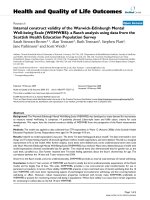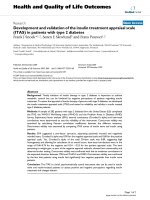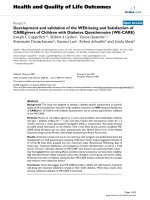báo cáo hóa học:" Nonopportunistic Neurologic Manifestations of the Human Immunodeficiency Virus: An Indian Study" pptx
Bạn đang xem bản rút gọn của tài liệu. Xem và tải ngay bản đầy đủ của tài liệu tại đây (234.22 KB, 10 trang )
BioMed Central
Page 1 of 10
(page number not for citation purposes)
Journal of the International AIDS Society
Open Access
Research article
Nonopportunistic Neurologic Manifestations of the Human
Immunodeficiency Virus: An Indian Study
Alaka K Deshpande*
1
and Mrinal M Patnaik
2
Address:
1
Professor and Head, Department of Retroviral Medicine, Grant Medical College & Sir JJ Group of Hospitals, Mumbai, India and
2
Chief
Resident, Department of Retroviral Medicine, Grant Medical College & Sir JJ Group of Hospitals, Mumbai, India
Email: Alaka K Deshpande* -
* Corresponding author
Abstract
Context: HIV-1 is a neurotropic virus. In a resource-limited country such as India, large populations of
affected patients now have access to adequate chemoprophylaxis for opportunistic infections (OIs),
allowing them to live longer. Unfortunately the poor availability of highly active antiretroviral therapy
(HAART) has allowed viral replication to proceed unchecked. This has resulted in an increase in the
debilitating neurologic manifestations directly mediated by the virus.
Objective: The main objective of this study was to identify and describe in detail the direct neurologic
manifestations of HIV-1 in antiretroviral treatment (ART)-naive, HIV-infected patients (excluding the
neurologic manifestations produced by opportunistic pathogens).
Design: Three hundred successive cases of HIV-1 infected, ART-naive patients with neurologic
manifestations were studied over a 3-year period. Each case was studied in detail to identify and then
exclude manifestations due to opportunistic pathogens. The remaining cases were then analyzed specially
in regard to their occurrence and the degree of immune suppression (CD4+ cell counts).
Setting and Patients: The study was carried out in an apex, tertiary, referral care center for HIV/AIDS
in India. All patients were admitted for a detailed analysis.
No interventions were carried out, as this was an observational study.
Results: Of the 300 cases, 67 (22.3%) had neurologic manifestations due to the direct effects of HIV-1.
The HIV infection involved the neuroaxis at all levels. The distribution of cases showed that the region
most commonly involved was the brain (50.7%). The manifestations included stroke syndromes (29.8%),
demyelinating illnesses (5.9%), AIDS dementia complex (5.9%), and venous sinus thrombosis (4.4%). The
other manifestations seen were peripheral neuropathies (35.8% of cases), spinal cord pathologies (5.9% of
cases), radiculopathies (4.4% of cases), and a single case of myopathy. The onset of occurrence of these
diseases and their progression were then correlated with the CD4+ cell counts.
Conclusion: HIV infection is responsible for a large number of nonopportunistic neurologic
manifestations that occur across a large immune spectrum. During the early course of the disease, the
polyclonal hypergammaglobulinemia induced by the virus results in demyelinating diseases of the central-
and peripheral nervous systems (CNS and PNS). As the HIV infection progresses, the direct toxic effects
of the virus unfold, directly damaging the CNS and PNS, resulting in protean clinical manifestations.
Published: 4 October 2005
Journal of the International AIDS Society 2005, 7:2
This article is available from: />Journal of the International AIDS Society 2005, 7:2 />Page 2 of 10
(page number not for citation purposes)
Introduction
HIV-1 is known to demonstrate a strong tropism for the
neurologic tissues right from the initial stages of infection.
The microglial cells in fact form one of the early and most
important reservoirs for this virus, where it lies dormant
until activated. With the advent of antiretroviral drugs and
effective chemoprophylaxis for OIs, the life span for
patients infected with HIV has increased considerably. In
a resource-limited country such as India, where antiretro-
viral drugs are not yet affordable for large sections of the
population, cheap and effective chemoprophylaxis for
OIs has significantly reduced morbidity and increased
longevity. All this has resulted in the observance of a large
number of clinical neurologic manifestations, which are
not due to OIs.
Neurologic manifestations occur over the entire spectrum
of HIV disease. During seroconversion aseptic meningitis,
Bell's palsy and acute encephalopathy can be seen. With
early immunodeficiency there is a polyclonal hypergam-
maglobulinemia resulting in a large number of demyeli-
nating and inflammatory disorders, such as CNS
demyelination, demyelinating and axonal forms of the
Guillain-Barré syndrome, polyneuritis cranialis, and poly-
myositis. With advanced immune suppression the direct
toxic effects of the virus come into play, predominantly
due to excessive and inappropriate elaboration of
cytokines, producing manifestations such as AIDS demen-
tia complex, distal painful sensory neuropathies, and vac-
uolar myelopathies.
A study of the various nonopportunistic neurologic man-
ifestations that can be seen due to HIV infection and their
association with the severity of immunodeficiency as
judged by the CD4+ cell count is presented here.
Materials and methods
Three hundred successive cases of ART-naive HIV-positive
patients presenting with neurologic manifestations were
enrolled in this study over a 3-year period. A written
informed consent, specifically detailing the study, was
taken from all of the patients along with prior approval
from the Institutional Ethics Review Committee. The pres-
ence of the HIV infection was confirmed as per the
National AIDS Control Organization guidelines. All of the
cases underwent detailed clinical evaluation, followed by
relevant laboratory investigations and appropriate neu-
roimaging, including computed tomography (CT) and
magnetic resonance imaging (MRI) scans. On the basis of
these results, the cases with OIs were then excluded from
further study. Those cases in which the neurologic mani-
festations were due to concomitant systemic illness or
medications were also excluded. The cases with no appar-
ent evidence of OIs were considered to be due to the direct
effects of the HIV infection and formed the study group.
Because HIV infection is known to affect all levels of the
neuroaxis, these patients were divided into specific sub-
categories. These included: (1) CNS meninges, brain, and
spinal cord; and (2) PNS anterior horn cells, radicles,
peripheral nerves, neuromuscular junction, and the mus-
cles. For each specific subcategory, multiple tests includ-
ing relevant neuroimaging, serology, and
electrophysiology were carried out to exclude the role of
opportunistic/systemic diseases in their pathogenesis. The
immune status was assessed on the basis of the CD4+ cell
counts using a fluorescent-activated cell sorter count. HIV
viral load could not be determined due to resource limita-
tions.
Results
A total of 300 successive cases of patients with HIV/AIDS
with neurologic manifestations were studied. These
patients were selected from internal medicine, neurology,
and retroviral clinics/wards, over a period of 3 years. Out
of these, 233 cases revealed an evidence of an opportunis-
tic infection involving the neuroaxis, while 67 cases
(22.3%) were due to the direct effects of HIV infection per
se. The cases, which were due to OIs, were then excluded
from further study. Table 1 shows the distribution of
cases, which were due to OIs or opportunistic cancers.
In the study group of patients with neurologic manifesta-
tions not due to opportunistic or concomitant diseases
other than HIV, 74% of cases were males (n = 50) and
26% were females (n = 17). This gender distribution
matches the demography of HIV-1 infection in India (M:F
ratio = 3:1). As the epidemic continues to grow, we are
seeing more and more females being infected through the
heterosexual mode of transmission. Table 2 depicts the
distribution of cases by age. Seventy-six percent of the
cases were in the 1545 years age group. The prevalence
rates shown in Table 2 are in concordance with the general
age-specific prevalence rates for HIV-1 infection in India.
The risk behavior for acquisition of HIV infection was ana-
lyzed; 92.5% of the cases were due to multipartner unpro-
tected heterosexual exposure; 2 cases were attributed to
intravenous drug use (IVDU), and there was a single case
of documented vertical transmission.
Table 3 shows the distribution of patients into different
categories depending on their clinical evaluation and
CD4+ cell counts. This categorization format is the 1993
revised classification for HIV infection and expanded case
definition for AIDS in adolescents and adults. The major-
ity of our patients fell into category C (60%), and 65% of
these cases were within the subcategory C3 as they had
CD4+ cell counts < 200 cells/microliter (mcL). The addi-
tion of pulmonary tuberculosis as an AIDS-defining con-
dition by the US Centers for Disease Control and
Prevention (CDC) in 1993 has resulted in a larger-than-
Journal of the International AIDS Society 2005, 7:2 />Page 3 of 10
(page number not for citation purposes)
expected number of cases being classified in India into
subcategory C3 due to the already high prevalence of
tuberculosis in the community/general population.
Stroke Syndromes
Strokes and transient neurologic deficits are commonly
seen with HIV/AIDS. There were 20 cases of stroke that
were apparently due to HIV infection per se. Ten patients
had a CD4+ cell count between 200 and 500 cells/mcL,
whereas 8 cases (40%) had a CD4+ cell count between
100 and 200 cells/mcL. The mean CD4+ cell count in the
study was found to be 212 cells/mcL.
The causes of strokes in this study were varied (Table 4).
Nine of the 20 cases were due to thrombotic occlusion of
large vessels. Four cases were due to probable vasculitis
(20%), and the remaining cases were caused by lacunar
infarcts, transient ischemic attacks (TIAs), and intracranial
bleeds.
The mechanism of the thrombotic occlusion of large ves-
sels was difficult to pinpoint. A large number of causes
have been proposed, making it essential to now consider
HIV as a prothrombotic state giving rise to strokes in rela-
tively young people. Of the 20 cases in our study with
HIV-related strokes, 15 were in the 1545 years age group.
Due to the enormous costs involved, it was not possible
to investigate the prevalence of specific known throm-
bophilic factors in these patients.
Vasculitis probably due to the HIV virus contributed to
20% (n = 4) of the stroke syndromes. These patients pre-
sented with focal deficits and advanced HIV disease. MRI
with angiograms revealed evidence of a focal segmental
narrowing of vessel walls, a feature of vasculitis. The cere-
brospinal fluid (CSF) was examined for antibodies to vari-
cella-zoster virus and cytomegalovirus as well as venereal
disease research laboratory slide test (VDRL) titers, as
these infections are known to cause vasculitis in the
absence of systemic manifestations of the primary disease.
However, CSF examination in these cases did not reveal
any of these antibodies, thereby indicating that the vascu-
litis was probably due to the direct effects of the retrovirus.
Table 1: Distribution of Cases, Attributed to Opportunistic Diseases (n = 233)
Infection/Cancer Number of Cases Mean CD4+ Cell Count (cells/mcL)
Neurologic toxoplasmosis 61 150
Neurologic tuberculoma 48 212
Cryptococcal meningitis 51 114
TB meningitis 24 160
Progressivemultifocal leukoencephalopathy 20 108
Primary CNS lymphoma 8 54
TB arachnoiditis radiculopathy 3 140
TB osteomyelitis myelopathy 4 234
Neurologic cysticercosis 4 350
Cryptococcoma 3 110
CMV radiculopathy 3 94
Varicella-zoster radiculopathy 2 100
CMV encephalitis 1 32
Varicella-zoster leptomeningitis 1 212
TOTAL 233
mcL = microliter; TB = tuberculosis; CNS = central nervous system; CMV = cytomegalovirus
Journal of the International AIDS Society 2005, 7:2 />Page 4 of 10
(page number not for citation purposes)
Two young patients with hemiplegia without any identifi-
able risk factors had lacunar infarcts in the basal ganglia
and the internal capsule.
Demyelination
Demyelination affecting the spinal cord in HIV disease is
well established, but of late, immune-mediated demyeli-
nation involving the brain is being reported with increas-
ing frequency. Four of our cases had clinical features
suggestive of a demyelinating disorder. The neuroimaging
features were very different from those of progressive
multifocal leukoencephalopathy, a close differential diag-
nosis.
Table 5 shows the clinical description and course of the
cases of HIV demyelination.
AIDS Dementia Complex
AIDS dementia complex was seen in 4 patients. This dis-
order manifested as a subacute, progressive, subcortical
dementia. All of the patients had advanced immune defi-
ciency. The average survival from the time of diagnosis
was 5 months. Table 6 demonstrates the profile of cases
with AIDS dementia complex.
Cortical Venous Sinus Thromboses
HIV infection gives rise to a prothrombotic state. The
potential contributing factors that have been identified
are: (1) anticardiolipin antibodies; (2) low levels of pro-
tein S; (3) deficiency of heparin cofactor 2; and (4) vascu-
lopathy.[1-3] There were 3 cases of cortical venous sinus
thrombosis. The patients had moderate-to-advanced
immune deficiency. They had no family history or previ-
ous episode of thrombophilia. Two of the 3 patients had
low levels of protein S and positive anticardiolipin anti-
bodies.
All 3 patients received heparin therapy followed by warfa-
rin for 3 months, and showed significant improvement.
CSF examination ruled out infectious etiologies of venous
sinus thrombosis. The clinical profile of each of these
cases is shown in Table 7.
HIV Neuropathy
There were 24 cases (38%) of neuropathy, 15 peripheral
neuropathies and 7 cranial neuropathies (Table 8). Cra-
nial neuropathies were identified in 9 patients. The most
common cranial neuropathy was a self-limiting Bell's
palsy, which was seen in 7 of the 9 cases, the remaining 2
being cases of polyneuritis cranialis.
Table 2: Distribution of Non-OI (HIV-Related) Cases by Age (n = 67)
Neurologic Manifestation < 15 yrs 1545 yrs 4660 yrs > 60 yrs
Brain
Stroke 0 15 5 0
Demyelination 1 2 1 0
AIDS dementia 0 4 0 0
Aseptic meningitis/encephalitis 0 3 0 0
Venous sinus thromboses 0 3 0 0
Cranial neuropathy 0 7 2 0
Spinal cord involvement 0 3 2 0
Radiculopathies 0 2 1 0
Peripheral neuropathies 0 12 2 1
Myopathies 0 0 1 0
TOTAL 1 51 14 1
Percentages < 1% 76% 20.8% < 1%
OI = opportunistic infection; yrs = years of age
Journal of the International AIDS Society 2005, 7:2 />Page 5 of 10
(page number not for citation purposes)
The most common cranial neuropathy seen was the
benign seventh cranial nerve palsy (Bell's palsy). The cases
of Bell's palsy were found to occur early in the HIV disease
and often during initial seroconversion. Clinically they
were indistinguishable from the classic Bell's palsy. The
CD4+ cell count of affected patients ranged from 356 to
511 cells/mcL, with a mean of 457 cells/mcL. CSF exami-
nations as well as neuroimaging in all of these cases were
normal. The disease was self-limited, with most of the
patients (85%) showing complete recovery within 2
weeks without any therapy. Only 1 patient who had pre-
sented with a low CD4+ cell count had partial recovery of
his facial weakness.
There were 2 cases of mononeuritis multiplex (Table 8)
thought to be secondary to vasculitis, of which only 1
could be confirmed by nerve biopsy. There were 5 cases of
distal predominantly sensory neuropathy (Table 8). There
were no cases of chronic inflammatory demyelinating
polyradiculoneuropathy or diffuse infiltrative lymphocy-
tosis syndrome identified.
There were 5 patients with distal symmetric predomi-
nantly painful sensory neuropathy, also known as distal
symmetrical polyneuropathy and distal symmetrical
peripheral neuropathy (Table 8). All of these cases were
seen in advanced states of HIV/AIDS. The predominant
manifestations in most (85%) were a painful burning sen-
sation in the feet with late and mild involvement of the
hands. The main abnormality found on clinical examina-
tion was loss of superficial sensations such as pain, tem-
Table 3: Classification of HIV Neurologic Manifestation Cases
by US Centers for Disease Control and Prevention Categories
(n = 67)
Manifestation B1B2B3C1C2C3
Brain
Stroke 045146
Demyelination 0 1 1 0 0 2
Aseptic meningitis 0 0 2 0 0 1
Venous sinus thrombosis 0 0 1 0 2 0
AIDS dementia complex 0 0 0 0 0 4
Cranial neuropathy
Bell's Palsy 4 3 0 0 0 0
Polyneuritis cranialis 0 1 0 0 1 0
Spinal cord
Vacuolar myelopathy 0 0 0 0 0 2
ATM 000001
Myeloradiculopathy 0 0 0 0 0 2
Peripheral neuropathy
Guillain-Barré syndrome
AIDP 130000
AMAN 0 1 0 0 1 0
AMSAN 000011
Mononeuritis multiplex 0 0 1 0 1 0
DPSN 010013
Radiculopathy 0 0 0 0 2 1
Myopathy 0 1 0 0 0 0
TOTAL 5 14 10 1 13 24
ATM = acute transverse myelitis; AIDP = acute inflammatory
demyelinating polyradiculoneuropathy; AMAN = acute motor axonal
neuropathy; AMSAN = acute motor and sensory axonal neuropathy;
DPSN = distal predominantly sensory neuropathy (also known as
distal symmetrical polyneuropathy and distal symmetrical peripheral
neuropathy)
Table 4: Cases of HIV Stroke Syndromes (n = 20)
Type of stroke CD4+ Cell Count (cells/mcL)
< 100 100200 200500 > 500
TIA 0 0 1 0
RIND 00 30
Large vessel thromboses 0 4 4 1
Vasculitis 1 2 1 0
IC bleeds 0 1 0 0
Lacunar strokes 01 10
TOTAL 1 8 10 1
% of total stroke syndromes 5% 40% 50% 5%
mcL = microliter; TIA = transient ischemic attack; RIND = reversible
ischemic neurologic deficit; IC = intracranial
Journal of the International AIDS Society 2005, 7:2 />Page 6 of 10
(page number not for citation purposes)
perature, and touch. In 1 case was the joint position and
vibration sense lost. Sixty percent of cases had an absent
ankle jerk. The neuropathy was bilaterally symmetrical in
all cases. The mean CD4+ cell count in this study was 141
cells/mcL, while the range extended from 98 to 212 cells/
mcL.
After HIV seroconversion, the polyclonal stimulation
resulting in hypergammaglobulinemia has been reported
to be associated with many immune-mediated condi-
tions, such as Guillain-Barré syndrome and immune-
mediated thrombocytic purpura. There were a total of 8
cases of the Guillain-Barré syndrome in this study (Table
8), of which 4 were identified on electrophysiology to be
demyelinating and the remaining 4 were axonal variants:
acute motor axonal neuropathy (AMAN) and acute motor
and sensory axonal neuropathy (AMSAN). The clinical
course was found to be no different from that of non-HIV
cases (Table 9). Three patients could afford intravenous
immunoglobulin (IVIG) and showed an excellent
response to treatment. The remaining patients were man-
aged conservatively, with only 1 requiring prolonged ven-
tilator support. Two patients with the axonal form of the
disease showed little improvement, while 1 patient was
lost to follow-up. The CSF analysis in these patients did
not show the classic albuminocytologic dissociation as
expected at the end of the first week. Seven out of 8
patients had a mild mononuclear pleocytosis along with
the raised protein levels.
HIV/AIDS Myelopathies
The spinal cord in HIV disease is frequently involved in
advanced stages of immunodeficiency. We had 2 cases of
vacuolar myelopathy, 2 cases of myeloradiculopathy, and
a single case of acute transverse myelitis. In Western liter-
ature it has been found that there is a significant overlap
between vacuolar myelopathy and the AIDS dementia
complex. This has been explained by the cytokine mecha-
nisms behind the origin of both entities, especially medi-
ated by tumor necrosis factor (TNF)-alpha. However, in
our study we did not find any overlap between the 2 con-
ditions. Table 10 shows the spectrum of myelopathies
seen in this study.
The single case that presented with acute transverse mye-
litis had a low CD4+ cell count: 56 cells/mcL. On MRI of
the spine, he was found to have a large segment of cord
inflammation of the spine and was subsequently treated
with steroids. However, there has been no improvement
at all. There were 2 cases of classic vacuolar myelopathy.
They presented with a spastic ataxic syndrome not having
a sensory level (ie, the neurologic lesions could not be
localized to a particular segment of the central nervous
system). There was a marked impairment of the joint posi-
tion and vibration sense. The vitamin B
12
levels in both of
these patients were normal and the spinal MRI revealed
subtle signal changes in the posterior columns of the spi-
nal cord. None of these patients had any clinical evidence
of the AIDS dementia complex.
Table 5: Cases of HIV Demyelination (n = 4)
Clinical presentation Age Sex CD4+ Cell Count Treatment Status
Hemiplegia, neuroregression and visual loss 10 yrs F 371 Nil Relapsing remitting
Cerebellar syndrome 40 yrs M 336 Antiretroviral therapy Improved
Hemiplegia with visual loss 54 yrs M 188 Steroids Died due to aspiration pneumonia
Hemiplegia with facial palsy 34 yrs M 320 Steroids Improved
Table 6: Cases of AIDS Dementia Complex (n = 4)
Stage of ADC Age Sex Route of Transmission CD4+ Cell Count(cells/mcL) Duration of Survival
Stage 2 38 M H 106 6 months
Stage 3 35 M H 115 2 months
Stage 4 35 M H 56 7 months
Stage 2 42 M H 120 5 months
mcL = microliter; ADC = AIDS dementia complex; M = male; H = heterosexual
Journal of the International AIDS Society 2005, 7:2 />Page 7 of 10
(page number not for citation purposes)
Radiculopathies
There were 3 cases of HIV radiculopathy. The cases were
associated with moderate-to-advanced immunodefi-
ciency. The CD4+ cell counts ranged from 186 to 265
cells/mcL. The mean CD4+ cell count was 217 cells/mcL.
We were able to analyze the CSF of all 3 patients for
cytomegalovirus by the polymerase chain reaction (PCR)
technique. CSF in all 3 patients was negative for cytomeg-
alovirus by PCR. The disease progression and course was
slow, and hence it was concluded that in these patients the
HIV infection probably caused the radiculopathy.
HIV Myopathies
There was a single case of proximal myopathy that was
probably linked to the HIV infection. The patient was a
44-year-old man who presented with proximal muscle
weakness. His CD4+ cell count was 465 cells/mcL and his
creatine phosphokinase (CPK) enzyme levels were highly
elevated. The patient had no OI and had never received
antiretroviral therapy. He was given a short course of ster-
oids and is showing good response. A muscle biopsy
could not be done on the patient due to lack of consent.
Discussion
This study has shown that HIV-1 is indeed a neurotropic
virus, which can produce a large variety of neurologic
manifestations affecting all levels of the neuroaxis.
Although OIs of the nervous system are still by far the
most commonly seen manifestations,[1] the availability
of good prophylactic and therapeutic medications for
these OIs has meant that more features of direct HIV neu-
roinvolvement are being seen.
The HIV viral RNA and other component proteins have
been demonstrated in neural tissues by processes such as
in situ hybridization and immunocytochemistry.[1,2]
Table 7: Cases of HIV Cortical Venous Sinus Thrombosis (n = 3)
Sinus involved Age Sex Mode of Transmission CD4+ Cell Count(cells/mcL) Treatment
Superior sagittal with transverse sinus 35 yrs M H 148 Heparin then warfarin
Superior sagittal with transverse and sigmoid
sinuses
26 yrs M H 212 Heparin then warfarin
Superior sagittal and straight sinus 30 yrs M H 256 Heparin then warfarin
mcL = microliter; M = male; H = heterosexual
Table 8: Cases of HIV Neuropathy (n = 24)
Type of neuropathy Males Females Total
Cranial neuropathy
Bell's palsy 5 2 7
Polyneuritis cranialis 2 0 2
Peripheral neuropathy
Guillain-Barré syndrome
AIDP 4 0 4
AMAN 1 1 2
AMSAN 2 0 2
Mononeuritis multiplex 2 0 2
Distal predominantly sensory neuropathy 4 1 5
TOTAL 20 4 24
Journal of the International AIDS Society 2005, 7:2 />Page 8 of 10
(page number not for citation purposes)
They have predominantly been isolated from the micro-
glial cells, giant cells, and capillary endothelial cells.[3]
The virus appears to enter the brain via the infected mac-
rophages, a pathogenic mechanism described by the "Tro-
jan horse hypothesis."[4] The total number of infected
cells is low, but the virus appears to induce widespread
neuronal dysfunction predominantly through cytokine
release.
Strokes and TIAs are commonly seen in patients with HIV
disease. Although a large number of them are due to OIs,
in approximately half there is no cause discernable apart
from the HIV disease itself. Clinical evidence of strokes
and TIAs has been found in approximately 1.5% of
patients with advanced HIV disease.[5,6] Brew and col-
leagues[5] found the mean CD4+ cell count to be 130 ±
80 cells/mcL, with most having CD4+ cell counts < 50
cells/mcL. These figures were derived from studies carried
out in ART-naive patients, very similar to the population
base in our country. In our study, 29.8% of non-OI man-
ifestations were stroke syndromes. Ten patients (50%)
had a CD4+ cell count between 200 and 500 cells/mcL,
whereas 8 cases had a CD4+ cell count between 100 and
200 cells/mcL. The mean CD4+ cell count in the study was
found to be 212 cells/mcL. Seventy-five percent of the
patients had a young stroke, aptly proving the fact that
HIV disease results in a prothrombotic state. This pro-
thrombotic state is due to a complex mix of effects of anti-
cardiolipin antibodies, low protein S levels, and altered
heparin cofactor II levels.[5-9] In addition to this, vasculi-
tis produced by the virus itself tends to be prothrombotic
due to the endothelial dysfunction, resulting in a signifi-
cant overlap between the two. In advanced HIV infection,
Table 9: Cases of Guillain-Barré Syndrome (n = 8)
Clinical features Age/Sex CD4+ Cell Count(cells/mcL) Type of GBS Therapy Status
Ascending paraparesis 23 y/M 335 AIDP IVIG Improved
Quadriplegia requiring ventilator 30 y/M 420 AIDP IVIG Improved
Ascending weakness with neck muscle
involvement
45 y/M 450 AMAN Steroids Improved
Quadriplegia 35 y/M 204 AMSAN Nil Mild improvement
Descending weakness with lower cranial nerve
palsies
34 y/M 195 AMSAN Nil Mild improvement
Quadriparesis 33 y/M 456 AIDP Steroids Improved
Ascending muscle weakness 35 y/F 400 AMAN IVIG Mild improvement
Paraparesis 42 y/M 450 AIDP Nil Not available
GBS = Guillain-Barré syndrome; IVIG = intravenous immunoglobulin; AIDP = acute inflammatory demyelinating polyradiculoneuropathy; AMAN =
acute motor axonal neuropathy; AMSAN = acute motor and sensory axonal neuropathy
Table 10: Cases of HIV Myelopathy (n = 5)
Age(yrs) Sex Route of Transmission CD4+ Cell Count Diagnosis Status
24 M H 56 ATM Stable
40 M IVDU 229 Vacuolar myelopathy Progressing
34 M H 120 Vacuolarmyelopathy Expired due to PCP
29 M H 98 Myeloradiculopathy Expired
29 M H 178 Myeloradiculopathy Stable
M = male; H = heterosexual; ATM = acute transverse myelitis; PCP = Pneumocystis carinii pneumonia
Journal of the International AIDS Society 2005, 7:2 />Page 9 of 10
(page number not for citation purposes)
excessive inappropriate elaboration of TNF alpha and
interleukin-1 add to the thrombophilia.[10]
In HIV disease most cases of demyelination involve the
spinal cord. In this study we found 4 cases (5%) that pre-
sented with CNS demyelination. Berger and cowork-
ers[11] reported 7 cases of multiple sclerosis-like illness in
HIV-positive patients. It is found to occur in the early
phases of the retroviral infection, where there is a polyclo-
nal hypergammaglobulinemia. The antibodies cross-react
with myelin in the CNS, resulting in the demyelination.
As the HIV disease progresses, with advancing immune
deficiency, it is observed that there is an improvement in
the clinical status of these patients.[12] This probably
arises from the fact that, with advancing immune defi-
ciency, the ability of the body to mount an immune-medi-
ated response progressively gets disabled. In this study, 2
out of 4 patients had marked improvement. One of them
had a relapsing-remitting form of disease, and 1 died due
to Pneumocystis carinii pneumonia.
In this study we found that 5% of the non-OI cases were
due to the AIDS dementia complex (ADC). Increasingly
more number of cases of ADC are going to be seen, due to
the availability of good prophylaxis and therapy for OIs.
Studies from western countries have shown that 20% to
30% of patients with advanced HIV infection go on to
develop ADC.[13]
Wadia and associates[14] reported 21 cases of ADC of a
total of 481 cases (4.3%) of HIV patients with neurologic
manifestations. The advent of antiretroviral therapy
(HAART) in western countries has led to significant reduc-
tion in the incidence of ADC.[15]
The bulk of the cases in this study, 38%, were constituted
by HIV neuropathy. It has been shown in different studies
that between 10% and 35% of HIV-infected individuals
develop a neuropathy that can be ascribed to the HIV
infection itself.[16,17] Histopathologic abnormalities in
peripheral nerves have been found in over 95% of patients
dying with AIDS.[18] Neuropathy is found to occur at all
stages of HIV infection. During seroconversion we saw
cases of facial neuropathy and acute inflammatory demy-
elinating neuropathies. As the disease advanced, monon-
euritis multiplex, secondary to vasculitis and polyneuritis
cranialis, were evident. Finally, with advanced HIV dis-
ease, there were cases of distal painful predominantly sen-
sory neuropathy. There were 8 cases of the Guillain-Barré
syndrome. One important feature seen in all of these
patients with Guillain-Barré syndrome was that their CSF
analysis at the end of the first week did not show the clas-
sic albuminocytologic dissociation. All studies have
shown either a raised protein level and or a mononuclear
pleocytosis.[19,20] Cornblath and colleagues[19] found
the mean CSF cell count to be 23 cells/mcL, with a maxi-
mum of 43 cells/mcL. In our study, all of the patients had
a slightly elevated CSF protein content, and the CD4+ cell
count ranged from 0 to 30 cells/mcL, with a mean of 15
cells/mcL.
By performing this study, we have realized that this dis-
ease is constantly evolving and placing new challenges in
front of the physician and the society. Right from its detec-
tion in 1981 up to the new millennium, every single year
that has passed by has seen this virus evolve and remain
elusive to medical therapy. Billions of dollars have been
spent in both prevention and cure, but still the epidemic
continues to grow, especially in third-world countries. In
the year 2000, the United Nations Security Council dis-
cussed this disease as an issue of global security in their
annual meeting. The youth of countries across the globe
were succumbing to the effects of the HIV infection
destroying the economic and social fabric of these coun-
tries.
In the current world scenario, with the advent of HAART
and effective chemoprophylaxis for OIs, there has been a
significant impact on the disease. However, as the inci-
dence of the opportunistic manifestations was reduced by
chemoprophylaxis, an entire spectrum of non-OI mani-
festations and drug related toxicities evolved.
From a physician's perspective, these non-OI manifesta-
tions are difficult to diagnose because of the lack of spe-
cific tests and limited knowledge that is available. Most of
these non-OI neurologic manifestations are crippling,
imposing huge burdens on the patient's family and the
healthcare system.
The treatments of most of these manifestations are lim-
ited. The initial immune-related phenomenon, such as
the Guillain-Barré syndrome, could be dealt with by using
immune globulins, plasmapheresis, and steroids. The
costs of immune globulins are exorbitant, and most insti-
tutions do not offer plasmapheresis facilities to HIV-posi-
tive patients. Use of corticosteroids in HIV patients for
both Guillain-Barré syndrome and demyelinating ill-
nesses always has to be done with apprehension, as these
patients are already immune-compromised and prone to
infection.
The ideal way to assess the relationship between the non-
OI neurologic manifestations and HIV disease progres-
sion is by estimating the plasma and CSF viral loads. In
India today the only affordable methodology is the esti-
mation of the CD4+ cell counts. There are laboratories
that estimate the plasma viral load, but the costs have
proven to be prohibitive. As far as the CSF viral load is
Publish with BioMed Central and every
scientist can read your work free of charge
"BioMed Central will be the most significant development for
disseminating the results of biomedical research in our lifetime."
Sir Paul Nurse, Cancer Research UK
Your research papers will be:
available free of charge to the entire biomedical community
peer reviewed and published immediately upon acceptance
cited in PubMed and archived on PubMed Central
yours — you keep the copyright
Submit your manuscript here:
/>BioMedcentral
Journal of the International AIDS Society 2005, 7:2 />Page 10 of 10
(page number not for citation purposes)
concerned, this technology remains to be introduced in
the country.
Funding Information
No financial support or grants were received for this work.
All patients were enrolled and treated free of cost at the
Government hospital in complete accordance with the
Government policy, after taking a detailed written
informed consent and with prior approval of the Institu-
tional Ethics Review Board.
Authors and Disclosures
Alaka K. Deshpande, MD, has disclosed no relevant finan-
cial relationships.
Mrinal M. Patnaik, MD, has disclosed no relevant finan-
cial relationships.
References
1. Snider WD, Simpson DM, Nielson S, et al.: Neurological complica-
tions of acquired immune deficiency syndrome: analysis of
50 patients. Ann Neurol 1983, 14:403-418. Abstract
2. Levy RM, Breseden DE, Rosenblum ML: Neurological manifesta-
tions of the acquired immune deficiency syndrome. Experi-
ence at UCSF and review of literature. J Neurosurg 1985,
62:475-495. Abstract
3. Gray F, Gheradi R, Scaravilli F: The neuropathology of acquired
immune deficiency syndrome. A review. Brain 1988, 111:245-266.
Abstract
4. Brew BJ: HIV Neurology Oxford, UK: Oxford University Press; 2001.
5. Brew BJ, Miller J: HIV related transient neurological deficits.
International Journal of medicine 1996, 101:257-261.
6. Engstrom JW, Lowenstein DH, et al.: Cerebral infarctions and
transient neurological deficits associated with AIDS. Am J
Med 1989, 86:528-532. Abstract
7. Lafeuillade A, Alessi MC, Poizot-Martin I, et al.: Protein S deficiency
and HIV infection. N Engl J Med 1991, 324:1220.
8. Stimmler MM, Quismorio FP, McGhee WG, et al.: Anti cardiolipin
antibodies in acquired immune deficiency syndrome. Arch
Intern Med 1989, 149:1833-1835. Abstract
9. Bissuel F, Berruyer M, Causse X, et al.: Acquired Protein S defi-
ciency; Correlation with advanced disease in HIV infection. J
Acquir Immun Defic Syndr 1992, 5:484-489.
10. Grimaldi LME, Martino GV, Franciotta DM, et al.: Elevated TNF
alpha levels in spinal fluid from HIV infections with CNS
involvement. Ann Neurol 1991, 29:21-25. Abstract
11. Berger JR, Sheremata WA, Resnik L, et al.
: Multiple Sclerosis like
illness occurring with HIV infection. Neurology 1989,
39:324-329. Abstract
12. Berger JR, Tornatore C, Major EO, et al.: Relapsing and remitting
HIV associated Leukoencephalopathy. Ann Neurol 1992,
31:34-38. Abstract
13. Navia B, Jordan BD, Price RW: The AIDS Dementia Complex:
clinical features. Ann Neurol 1986, 19:517-524. Abstract
14. Wadia RS, Pujari SN, et al.: Neurological manifestations of HIV
disease. J Assoc Physicians India 1998, 49:343-348.
15. Brew BJ: AIDS dementia complex and its prevention. Antiviral
Ther 1997, 2(suppl 3):69-73.
16. Leger JM, Bouche P, Bolgert F, et al.: the spectrum of polyneu-
ropathies in patients infected with HIV. J Neurol Neurosurg Psy-
chiatry 1989, 52:1369-1374. Abstract
17. Tagliati M, Grinell J, Godbold J, et al.: Peripheral nerve function in
HIV infection. Arch Neurol 1999, 56:84-89. Abstract
18. Fuller GN, Jacobs JM, Guiloff RJ: Nature and incidence of periph-
eral nerve syndromes in HIV infection. J Neurol Neurosurg Psy-
chiatry 1993, 56:372-381. Abstract
19. Cornblath DR, McArthur JC, Kennedy PGE, et al.: Inflamatory
demyelinating peripheral neuropathies associated with the
human T cell lymphotropic virus type 3 infections. Ann Neurol
1987, 2:32-40.
20. Mishra BB, Sommers W, Koski CK, et al.: Acute Inflamatory
demyelinating polyneuropathy in the acquired immune defi-
ciency syndrome. Ann Neurol 1985, 17:131.
